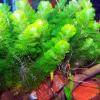Cabomba furcata
Scientific name: Cabomba furcata
Family: Cabombaceae
Maximum size reached under cultivation: 30 - 90 cm (11.81 - 35.43 inch)
014
Recommended pH range: 6 - 7.5
Recommended water hardness: 0 - 8°dGH (0 - 142.86ppm)
0°C 32°F30°C 86°F
Recommended temperature range: 22 - 28 °C (71.6 - 82.4°F)
Preferred propagation method: Cuttings
Native to: South America
Growth rate: Fast
Recommended substrate: Gravel
Lighting requirements: Bright
Ideal placement in tank: Background
🌿 Family
Cabombaceae. This small family of aquatic plants is primarily represented by the genus Cabomba, known for its delicate, submerged foliage.
🌿 Common Names
Cabomba furcata is commonly known as Red Cabomba or Forked Fanwort.
🌍 Origin
Cabomba furcata is native to the freshwater habitats of South America, particularly in countries like Brazil and Argentina. It thrives in slow-moving rivers, streams, and swampy areas with warm, nutrient-rich water and abundant sunlight. In addition to its native range, it has spread to parts of the Caribbean, including Cuba, and southeastern areas of the United States such as Florida, where it grows in similar freshwater environments. Its broad distribution highlights its adaptability, though in some regions it is considered an invasive species.
💡 Lighting Requirements
Cabomba furcata requires bright to intense lighting conditions to thrive. Without sufficient light, it loses its vibrant coloration, becomes leggy, and drops lower leaves. Full-spectrum aquarium lights that mimic daylight (30–50 PAR at the surface) are ideal. Consistent lighting for 8–10 hours daily ensures compact growth and vivid red hues.
💧 Water Parameters
- Temperature: 22–28 °C (71.6–82.4 °F)
- pH: 6.0–7.5
- Water Hardness: Soft to slightly hard (0–8 °dGH)
🌱 Propagation
Propagation is straightforward via stem cuttings. Cut healthy stems just below a node, gently remove lower leaves, and insert the cutting into the substrate. Handling must be delicate to avoid crushing the stems. Planting groups of cuttings together creates a denser effect. With bright light and stable conditions, cuttings will quickly root and develop into full plants.
⚖️ Difficulty
Moderate. While not extremely demanding, Cabomba furcata requires stable water parameters, bright lighting, and nutrient support to maintain its decorative qualities. Beginners without controlled environments may find it challenging.
🏡 Planting Area
Cabomba furcata is best used in the background of aquariums, where it creates a soft, flowing thicket. It can also help conceal aquarium equipment like heaters and filters, adding to the natural appearance of the setup.
🔧 Maintenance Tips
- Regular trimming of tops encourages bushier growth and prevents over-shading.
- Remove old or damaged stems to maintain health and aesthetics.
- Avoid sudden temperature or pH swings, which may cause shedding of stems and leaves.
🔬 Categorization
Cabomba furcata is a fully aquatic species. It must remain submerged at all times and cannot survive in emersed or floating conditions. It is classified strictly under the Aquatic category.
📝 Short Description
Cabomba furcata is a breathtakingly beautiful aquatic plant known for its vivid red to pinkish feathery foliage. Its delicate appearance adds a striking contrast to green plants and creates a flowing, natural motion in aquascapes. Although fragile and sensitive to environmental changes, it rewards careful aquarists with lush, colorful thickets. In aquariums, it is also commonly used to conceal heaters and filters, providing a more natural look. However, it is favored by herbivorous fish, so tankmate selection should be made thoughtfully. Successful cultivation hinges on bright lighting, nutrient supplementation, stable water conditions, and gentle maintenance practices.

 Cabomba caroliniana
Cabomba caroliniana